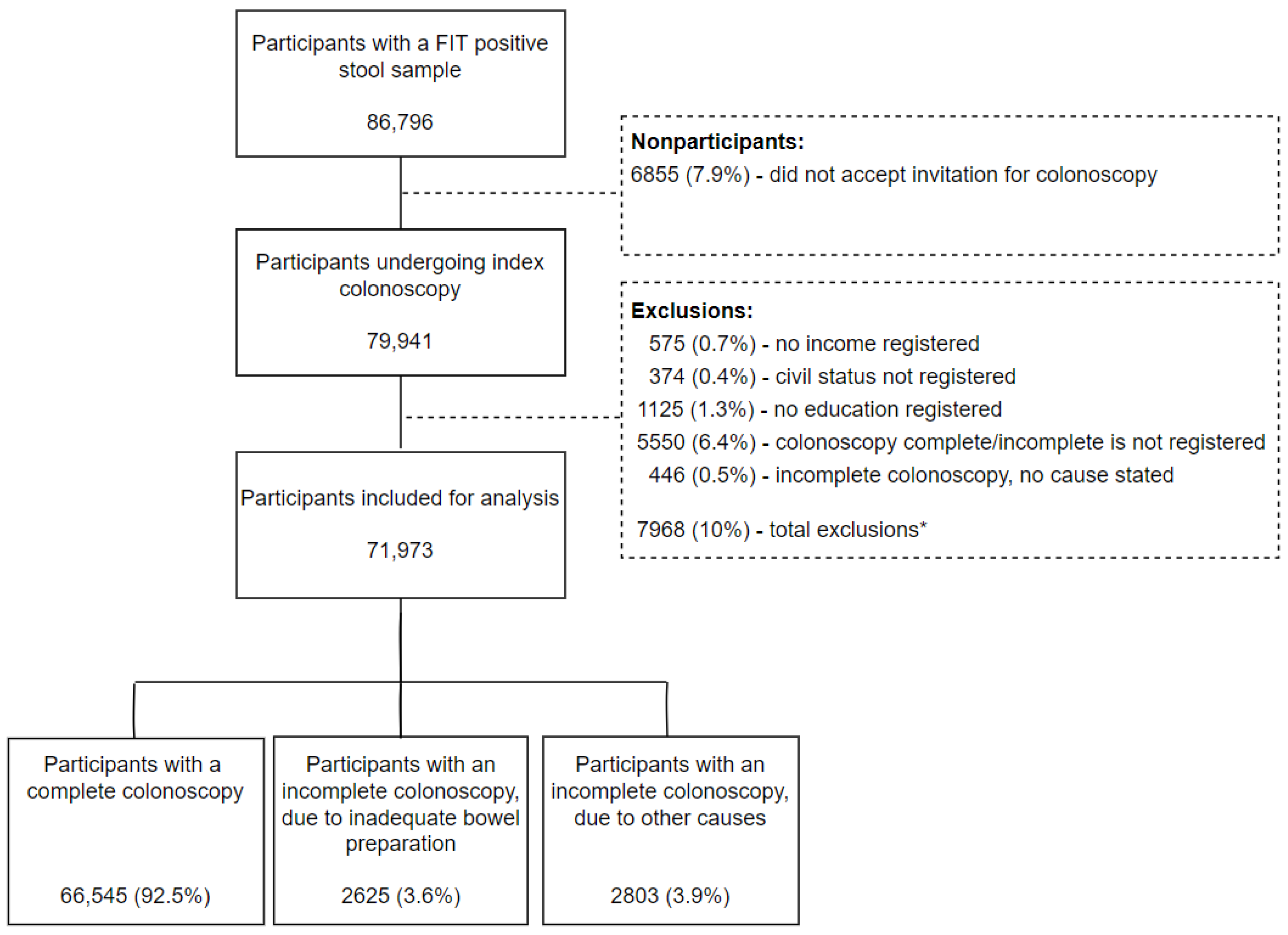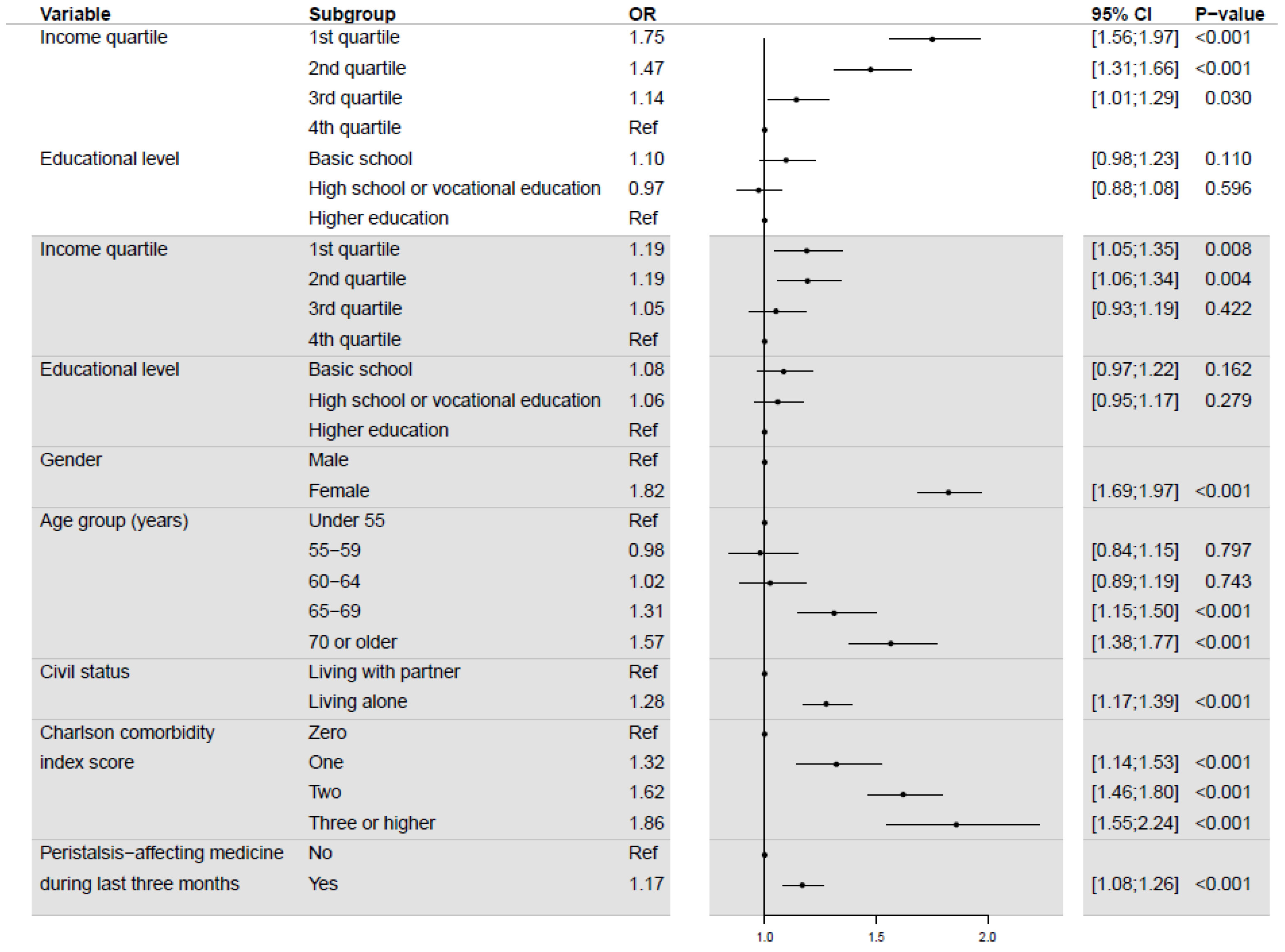Odds of Incomplete Colonoscopy in Colorectal Cancer Screening Based on Socioeconomic Status
Abstract
:1. Introduction
2. Materials and Methods
2.1. Study Population and Design
2.2. Data Sources
2.3. Study Variables
2.4. Statistical Analysis
2.5. Ethics
3. Results
4. Discussion
5. Conclusions
Author Contributions
Funding
Institutional Review Board Statement
Informed Consent Statement
Data Availability Statement
Conflicts of Interest
References
- Cardoso, R.; Guo, F.; Heisser, T.; Hackl, M.; Ihle, P.; De Schutter, H.; Van Damme, N.; Valerianova, Z.; Atanasov, T.; Májek, O.; et al. Colorectal cancer incidence, mortality, and stage distribution in European countries in the colorectal cancer screening era: An international population-based study. Lancet Oncol. 2021, 22, 1002–1013. [Google Scholar] [CrossRef]
- Arbejdsgruppen vedr. registrering i screeningsprogrammet for tarmkræft. Den tværregionale implementeringsgruppe vedr. tarmkræftscreening Danske Regioner. Screenings- og adenomkontrol program for tyk- og endetarmskræft. In Guidelines for Koloskopi og Patologi; Danske Regioner: København, Denmark, 2014. [Google Scholar]
- Bollart, A.S.; Manfredi, S.; Piette, C.; Bretagne, J.F. Frequency and efficacy of additional investigations following incomplete colonoscopies: A population-based analysis. Dig. Liver Dis. 2015, 47, 720–725. [Google Scholar] [CrossRef] [PubMed]
- Franco, D.L.; Leighton, J.A.; Gurudu, S.R. Approach to Incomplete Colonoscopy: New Techniques and Technologies. Gastroenterol. Hepatol. 2017, 13, 476–483. [Google Scholar]
- Shah, H.A.; Paszat, L.F.; Saskin, R.; Stukel, T.A.; Rabeneck, L. Factors associated with incomplete colonoscopy: A population-based study. Gastroenterology 2007, 132, 2297–2303. [Google Scholar] [CrossRef]
- Qureshi, A.; BiBi, S.; Madhotra, R. Body mass index & low CIR in colonoscopy! Gastroenterol. Hepatol. Bed Bench 2018, 11, 125–130. [Google Scholar]
- Gupta, M.; Holub, J.L.; Eisen, G. Do indication and demographics for colonoscopy affect completion? A large national database evaluation. Eur. J. Gastroenterol. Hepatol. 2010, 22, 620–627. [Google Scholar] [CrossRef] [Green Version]
- Anderson, J.C.; Gonzalez, J.D.; Messina, C.R.; Pollack, B.J. Factors that predict incomplete colonoscopy: Thinner is not always better. Am. J. Gastroenterol. 2000, 95, 2784–2787. [Google Scholar] [CrossRef]
- Britton, E.J.; Sidhu, S.; Geraghty, J.; Psarelli, E.; Sarkar, S. The 5-year outcome of patients having incomplete colonoscopy. Colorectal Dis. 2015, 17, 298–303. [Google Scholar] [CrossRef]
- Olsen, M.; Kjær, T.K.; Dalton, S.O. Social Ulighed i Kræft i Danmark; Kræftens Bekæmpelses Center for Kræftforskning: København, Denmark, 2019. [Google Scholar]
- Deding, U.; Henig, A.S.; Salling, A.; Torp-Pedersen, C.; Bøggild, H. Sociodemographic predictors of participation in colorectal cancer screening. Int. J. Colorectal Dis. 2017, 32, 1117–1124. [Google Scholar] [CrossRef] [PubMed]
- Deding, U.; Henig, A.S.; Hindersson, P.; Torp-Pedersen, C.; Bøggild, H. Determinants of non-participation in colon examination following positive stool sample in colorectal cancer screening. Eur. J. Public Health 2019, 29, 1118–1124. [Google Scholar] [CrossRef]
- Deding, U.; Torp-Pedersen, C.; Bøggild, H. The association between immigration status and ineligible stool samples for colorectal cancer screening. Cancer Epidemiol. 2018, 57, 74–79. [Google Scholar] [CrossRef] [PubMed]
- Sundhedsstyrelsen. Opstart af Det Nationale Screeningsprogram for Tyk- og Endetarmskræft, 2014–2016. Sundhedsstyrelsens Monitoreringsrapport; Sundhedsstyrelsen: København, Denmark, 2018. [Google Scholar]
- Dansk Tarmkræftscreeningsdatabase. Årsrapport 2017-Nationale Prævalens Screeningsrunde; Dansk Tarmkræftsscreeningsdatabase: Denmark, 2018. [Google Scholar]
- Thomsen, M.K.; Njor, S.H.; Rasmussen, M.; Linnemann, D.; Andersen, B.; Baatrup, G.; Friis-Hansen, L.J.; Jørgensen, J.C.R.; Mikkelsen, E.M. Validity of data in the Danish Colorectal Cancer Screening Database. Clin. Epidemiol. 2017, 9, 105–111. [Google Scholar] [CrossRef] [Green Version]
- Lynge, E.; Sandegaard, J.L.; Rebolj, M. The Danish National Patient Register. Scand. J. Public Health 2011, 39 (Suppl. 7), 30–33. [Google Scholar] [CrossRef]
- Pottegård, A.; Schmidt, S.A.J.; Wallach-Kildemoes, H.; Sørensen, H.T.; Hallas, J.; Schmidt, M. Data Resource Profile: The Danish National Prescription Registry. Int. J. Epidemiol. 2016, 46, 798-f. [Google Scholar] [CrossRef] [PubMed]
- Jensen, V.M.; Rasmussen, A.W. Danish Education Registers. Scand. J. Public Health 2011, 39 (Suppl. 7), 91–94. [Google Scholar] [CrossRef] [Green Version]
- Baadsgaard, M.; Quitzau, J. Danish registers on personal income and transfer payments. Scand. J. Public Health 2011, 39 (Suppl. 7), 103–105. [Google Scholar] [CrossRef] [PubMed]
- Quan, H.; Li, B.; Couris, C.M.; Fushimi, K.; Graham, P.; Hider, P.; Januel, J.-M.; Sundararajan, V. Updating and validating the Charlson comorbidity index and score for risk adjustment in hospital discharge abstracts using data from 6 countries. Am. J. Epidemiol. 2011, 173, 676–682. [Google Scholar] [CrossRef] [Green Version]
- World Health Organization. Health Literacy–The Solid Facts; World Health Organization: Copenhagen, Denmark, 2013. [Google Scholar]
- Friis, K.; Lasgaard, M.; Osborne, R.H.; Maindal, H.T. Gaps in understanding health and engagement with healthcare providers across common long-term conditions: A population survey of health literacy in 29 473 Danish citizens. BMJ Open. 2016, 6, e009627. [Google Scholar] [CrossRef] [PubMed] [Green Version]
- Kunnackal John, G.; Thuluvath, A.J.; Carrier, H.; Ahuja, N.K.; Gupta, E.; Stein, E. Poor Health Literacy and Medication Burden Are Significant Predictors for Inadequate Bowel Preparation in an Urban Tertiary Care Setting. J. Clin. Gastroenterol. 2019, 53, e382–e386. [Google Scholar] [CrossRef]
- Davis, T.; Hancock, J.; Morris, J.; Branim, P.; Seth, A.; Rademaker, A.; Arnold, C. Impact of Health Literacy-directed Colonoscopy Bowel Preparation Instruction Sheet. Am. J. Health Behav. 2017, 41, 301–308. [Google Scholar] [CrossRef] [PubMed]
- Martel, M.; Ménard, C.; Restellini, S.; Kherad, O.; Almadi, M.; Bouchard, M.; Barkun, A.N. Which Patient-Related Factors Determine Optimal Bowel Preparation? Curr. Treat. Options Gastroenterol. 2018, 16, 406–416. [Google Scholar] [CrossRef] [PubMed]
- Gandhi, K.; Tofani, C.; Sokach, C.; Patel, D.; Kastenberg, D.; Daskalakis, C. Patient Characteristics Associated With Quality of Colonoscopy Preparation: A Systematic Review and Meta-analysis. Clin. Gastroenterol. Hepatol. 2018, 16, 357–369. [Google Scholar] [CrossRef] [PubMed]
- Frederiksen, B.L.; Jørgensen, T.; Brasso, K.; Holten, I.; Osler, M. Socioeconomic position and participation in colorectal cancer screening. Br. J. Cancer 2010, 103, 1496–1501. [Google Scholar] [CrossRef] [PubMed]
- Dansk Tarmkræftscreeningsdatabase. Årsrapport 2018; Dansk Tarmkræftscreeningsdatabase: Denmark, 2020. [Google Scholar]



| Inadequate Bowel Preparation | |||||
|---|---|---|---|---|---|
| Variables | Level | Complete (%) * n = 66,545 | Incomplete (%) * n = 2625 | Total (%) ** n = 69,170 | p-Value |
| Income quartile | 1st quartile | 15,947 (94.7) | 892 (5.3) | 16,839 (24.3) | |
| 2nd quartile | 16,489 (96.0) | 691 (4.0) | 17,180 (24.8) | ||
| 3rd quartile | 16,938 (96.7) | 570 (3.3) | 17,508 (25.3) | ||
| 4th quartile | 17,171 (97.3) | 472 (2.7) | 17,643 (25.5) | <0.001 | |
| Educational level | Basic school | 18,424 (95.4) | 890 (4.6) | 19,314 (27.9) | |
| High school or vocational education | 31,879 (96.5) | 1151 (3.5) | 33,030 (47.8) | ||
| Higher education | 16,242 (96.5) | 584 (3.5) | 16,826 (24.3) | <0.001 | |
| Gender | Male | 37,806 (96.3) | 1460 (3.7) | 39,266 (56.8) | |
| Female | 28,739 (96.1) | 1165 (3.9) | 29,904 (43.2) | 0.2338 | |
| Age group (years) | Under 55 | 11,365 (96.1) | 467 (3.9) | 11,832 (17.1) | |
| 55–59 | 9286 (96.4) | 349 (3.6) | 9635 (13.9) | ||
| 60–64 | 11,957 (96.5) | 433 (3.5) | 12,390 (17.9) | ||
| 65–69 | 14,508 (96.0) | 601 (4.0) | 15,109 (21.9) | ||
| 70 or older | 19,429 (96.2) | 775 (3.8) | 20,204 (29.2) | 0.1940 | |
| Charlson comorbidity | Zero | 53,442 (96.6) | 1884 (3.4) | 55,326 (80.0) | |
| index score | One | 3899 (93.7) | 263 (6.3) | 4162 (6.0) | |
| Two | 7512 (95.5) | 355 (4.5) | 7867 (11.4) | ||
| Three or higher | 1692 (93.2) | 123 (6.8) | 1815 (2.6) | <0.001 | |
| Civil status | Living with partner | 48,444 (96.7) | 1660 (3.3) | 50,104 (72.4) | |
| Living alone | 18,101 (94.9) | 965 (5.1) | 19,066 (27.6) | <0.001 | |
| Peristalsis-affecting medicine | No | 40,414 (97.2) | 1143 (2.8) | 41,557 (60.1) | |
| during last three months | Yes | 26,131 (94.6) | 1482 (5.4) | 27,613 (39.9) | <0.001 |
| Other Reasons | |||||
|---|---|---|---|---|---|
| Variables | Level | Complete (%) * n = 66,545 | Incomplete (%) * n = 2803 | Total (%) ** n = 69,348 | p-Value |
| Income quartile | 1st quartile | 15,947 (94.7) | 896 (5.3) | 16,843 (24.3) | |
| 2nd quartile | 16,489 (95.5) | 768 (4.5) | 17,257 (24.9) | ||
| 3rd quartile | 16,938 (96.6) | 605 (3.4) | 17,543 (25.3) | ||
| 4th quartile | 17,171 (97.0) | 534 (3.0) | 17,705 (25.5) | <0.001 | |
| Educational level | Basic school | 18,424 (95.3) | 918 (4.7) | 19,342 (27.9) | |
| High school or vocational education | 31,879 (96.1) | 1287 (3.9) | 33,166 (47.8) | ||
| Higher education | 16,242 (96.4) | 598 (3.6) | 16,840 (24.3) | <0.001 | |
| Gender | Male | 37,806 (97.0) | 1152 (3.0) | 38,958 (56.2) | |
| Female | 28,739 (94.6) | 1651 (5.4) | 30,390 (43.8) | <0.001 | |
| Age group (years) | Under 55 | 11,365 (96.9) | 368 (3.1) | 11,733 (16.9) | |
| 55–59 | 9286 (97.0) | 292 (3.0) | 9578 (13.8) | ||
| 60–64 | 11,957 (96.8) | 394 (3.2) | 12,351 (17.8) | ||
| 65–69 | 14,508 (95.8) | 643 (4.2) | 15,151 (21.9) | ||
| 70 or older | 19,429 (94.6) | 1106 (5.4) | 20,535 (29.6) | <0.001 | |
| Charlson comorbidity | Zero | 53,442 (96.5) | 1962 (3.5) | 55,404 (79.9) | |
| index score | One | 3899 (94.6) | 224 (5.4) | 4123 (5.9) | |
| Two | 7512 (94.0) | 482 (6.0) | 7994 (11.5) | ||
| Three or higher | 1692 (92.6) | 135 (7.4) | 1827 (2.6) | <0.001 | |
| Civil status | Living with partner | 48,444 (96.4) | 1798 (3.6) | 50,242 (72.4) | |
| Living alone | 18,101 (94.7) | 1005 (5.3) | 19,106 (27.6) | <0.001 | |
| Peristalsis-affecting medicine | No | 40,414 (96.5) | 1464 (3.5) | 41,878 (60.4) | |
| during last three months | Yes | 26,131 (95.1) | 1339 (4.9) | 27,470 (39.6) | <0.001 |
Publisher’s Note: MDPI stays neutral with regard to jurisdictional claims in published maps and institutional affiliations. |
© 2022 by the authors. Licensee MDPI, Basel, Switzerland. This article is an open access article distributed under the terms and conditions of the Creative Commons Attribution (CC BY) license (https://creativecommons.org/licenses/by/4.0/).
Share and Cite
Skau, B.; Deding, U.; Kaalby, L.; Baatrup, G.; Kobaek-Larsen, M.; Al-Najami, I. Odds of Incomplete Colonoscopy in Colorectal Cancer Screening Based on Socioeconomic Status. Diagnostics 2022, 12, 171. https://doi.org/10.3390/diagnostics12010171
Skau B, Deding U, Kaalby L, Baatrup G, Kobaek-Larsen M, Al-Najami I. Odds of Incomplete Colonoscopy in Colorectal Cancer Screening Based on Socioeconomic Status. Diagnostics. 2022; 12(1):171. https://doi.org/10.3390/diagnostics12010171
Chicago/Turabian StyleSkau, Birgitte, Ulrik Deding, Lasse Kaalby, Gunnar Baatrup, Morten Kobaek-Larsen, and Issam Al-Najami. 2022. "Odds of Incomplete Colonoscopy in Colorectal Cancer Screening Based on Socioeconomic Status" Diagnostics 12, no. 1: 171. https://doi.org/10.3390/diagnostics12010171
APA StyleSkau, B., Deding, U., Kaalby, L., Baatrup, G., Kobaek-Larsen, M., & Al-Najami, I. (2022). Odds of Incomplete Colonoscopy in Colorectal Cancer Screening Based on Socioeconomic Status. Diagnostics, 12(1), 171. https://doi.org/10.3390/diagnostics12010171






